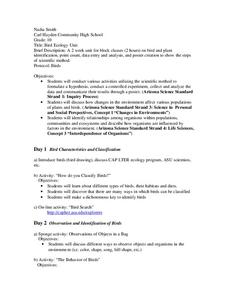Curated OER
Bird Ecology Unit
Tenth graders conduct various activities utilizing the scientific method to formulate a hypothesis, conduct a controlled experiment, collect and analyze the data and communicate their results through a poster. They also identify...
Curated OER
Mollusk Matching
Young scholars look carefully at shells and observe the differences between
species and the names of common shells. Then they identify and complete a Mollusk Matching handout included in the lesson and write the letter of each shell in...
Curated OER
Insect Pitfall Traps
Students ask testable questions, use the inquiry cycle to investigate, gather data and interpret the results, study the diversity of insects and other smallorganisms which live around the school; they can make an inventory /collection of...
Curated OER
Paleoecology Using "Fossilized" Owl Pellets
Students study the differences in anatomy to help identify different species and use a dichotomous key to identify what the owls were eating. In this investigative activity students dissect owl pellets to identify the species eaten...
Curated OER
Dichotomous Key
Students develop an understanding of how a dichotomous key is organized. In this dichotomous lesson, student are put into small groups, and work together dividing their group of similar objects (buttons, paper clips, screws, keys...)...
Curated OER
Paleoecology of "Fossilized" Owl Pellets
Students examine fossilized owl pellets to determine how a species environmental preferences allow us to reconstruct probable past environments. Differences in anatomy are used to identify species in this lesson.
Utah Education Network
Uen: Classifying Conundrum
In this activity, 4th graders will identify plant characteristics from different environments.








